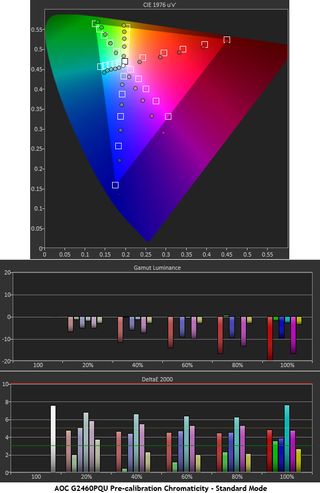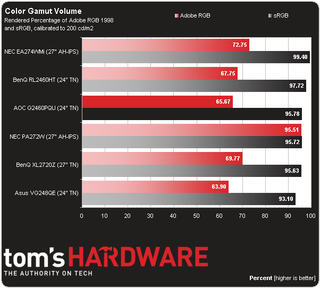AOC G2460PQU 24-inch 144 Hz Gaming Monitor Review
Not many monitors can run at 144 Hz, but AOC is adding to your list of choices with its G2460PQU 24-inch TN-based screen. We’ve already tested similar displays from Asus and BenQ. Can AOC match their speed and performance at a roughly $250 price point?
Why you can trust Tom's Hardware
Results: Color Gamut And Performance
Color gamut is measured using a saturation sweep that samples the six main colors (red, green, blue, cyan, magenta, and yellow) at five saturation levels (20, 40, 60, 80, and 100%). This provides a more realistic view of color accuracy.
In the G2460PQU’s case, calibration has a noticeable effect on gamut accuracy, so we’re showing the before and after results.

Without calibration, the G2460PQU tracks pretty close to the sRGB/Rec.709 standard. The main issues are the over-saturation of blue, and hue errors in magenta and cyan. Hue is usually corrected by a grayscale calibration. But color saturation can only be adjusted using a CMS, which this display does not have. To compensate, AOC decreases luminance for blue and magenta.
Adjusting the RGB sliders and selecting the Gamma 2 preset results in a much better chart.

Blue and magenta are still over-saturated. However, the hue errors are now much smaller. Not only that, luminance is much improved across the board. The resulting drop in Delta E errors is pretty significant. We’d love to have a functioning CMS on every display to achieve even better results, but it’s easy to see how much improvement can be made with a simple grayscale calibration and proper gamma selection.
Now we return to the comparison group.

The G2460PQU’s average color error is a low 2.00 Delta E. That's not good enough to pierce the rarified space of professional displays. It does beat the other two 144 Hz screens in our group, though. BenQ’s RL2460HT almost qualifies as an over-achiever, posting results as good as some very expensive factory-calibrated monitors.
Gamut Volume: Adobe RGB 1998 And sRGB
There are basically two categories of displays in use today: those that conform to the sRGB/Rec. 709 standard like HDTVs, and wide-gamut panels that show as much as 100 percent of the Adobe RGB 1998 spec. We use Gamutvision to calculate the gamut volume, based on an ICC profile created from our actual measurements.

The AOC comes within a whisker of filling the complete sRGB gamut volume. If it weren’t for slight discrepancies in magenta and green, it would render that last four percent easily. Given our results, we consider the G2460PQU an excellent choice for gaming, video content, or productivity. You can edit photos, too, if the wider Adobe RGB 1998 gamut isn’t necessary.
Current page: Results: Color Gamut And Performance
Prev Page Results: Grayscale Tracking And Gamma Response Next Page Results: Viewing Angles And UniformityStay on the Cutting Edge
Join the experts who read Tom's Hardware for the inside track on enthusiast PC tech news — and have for over 25 years. We'll send breaking news and in-depth reviews of CPUs, GPUs, AI, maker hardware and more straight to your inbox.

Christian Eberle is a Contributing Editor for Tom's Hardware US. He's a veteran reviewer of A/V equipment, specializing in monitors. Christian began his obsession with tech when he built his first PC in 1991, a 286 running DOS 3.0 at a blazing 12MHz. In 2006, he undertook training from the Imaging Science Foundation in video calibration and testing and thus started a passion for precise imaging that persists to this day. He is also a professional musician with a degree from the New England Conservatory as a classical bassoonist which he used to good effect as a performer with the West Point Army Band from 1987 to 2013. He enjoys watching movies and listening to high-end audio in his custom-built home theater and can be seen riding trails near his home on a race-ready ICE VTX recumbent trike. Christian enjoys the endless summer in Florida where he lives with his wife and Chihuahua and plays with orchestras around the state.
-
PandaV4 I have a AOC G2460P monitor myself, and a unpleasant surprise was that refresh rate of 144 Hz wasn't supported if using the DisplayPort connection. Does G2460PQU have the same limitations, or does it actually support 144 Hz over DisplayPort?Reply -
PandaV4 After some googling it seems that G2460PQU and G2460P is the same model. So beware if you want to use Displayport you wont be able to use the 144 Hz setting too! And this doesn't have any blur reduction either! It seems there is actually a new updated model to be released this month the AOC G2460PG. And it has nvidia g-sync support and blur reduction, and supports 144 over dIsplayport.Reply
TL;DR: G2460PQU = DO NOT BUY, G2460PG = BUY. -
ceberle Reply13687399 said:I have a AOC G2460P monitor myself, and a unpleasant surprise was that refresh rate of 144 Hz wasn't supported if using the DisplayPort connection. Does G2460PQU have the same limitations, or does it actually support 144 Hz over DisplayPort?
The PQU does accept 144 Hz over DisplayPort.
-Christian- -
PandaV4 Reply
A bit of googling brought up this article - http://pcmonitors.info/reviews/aoc-g2460pqu which says: " The image provided by DisplayPort is very similar on this monitor and it should also support the maximum (144Hz) refresh rate. Unfortunately that was not the case during our testing" and "The PC resolutions below this should feature 1920 x 1080 with 100Hz, 120Hz and 144Hz selectable – but that isn’t the case.". It seems there are different revisions of this monitor with the same model number. So if you buy one of those than you are practically gambling about the 144 Hz support.13688062 said:13687399 said:I have a AOC G2460P monitor myself, and a unpleasant surprise was that refresh rate of 144 Hz wasn't supported if using the DisplayPort connection. Does G2460PQU have the same limitations, or does it actually support 144 Hz over DisplayPort?
The PQU does accept 144 Hz over DisplayPort.
-Christian-
-
npyrhone Will we ever see here a review of even one non-TN gaming monitor? The reduced color depth renders to image quality absolutely disgusting.Reply
I will be the first one to congratulate you when you publish the next review of a monitor with a non-TN panel working over 60Hz. -
3Dns I have that model too and i buy it after a HP 23xi IPS LED Panel.Reply
I understand that.
It doesnt worth 300€ for this model. All you need is 60hz and 24" Panel that you can take it with 120€. For me IPS Panels offer you way better colors so for me its better. Now if you want it for a GTX780 and above and you wanna play over 60FPS it may worth.
But have in mind that a normal monitor cost ~120$ and this model cost double. You can spend that money in other hardware areas like better GPU for example. -
Adroid Sorry, but I won't ever buy another 1080p "gaming" display. 1920x1200 is vastly superior for "gaming" screens, and it's a shame the industry has veered away from it.Reply
I guess the thought process involves "and you can watch HD movies on it". Needless to say the 16:9 ratio is cheaper for manufacturers, and it's a great sales pitch. Well, give me a break. I got suckered into that line of thinking and I probably watched 2-3 movies on my "gaming" 23 inch monitor in 4-5 years.
Let's keep the movies where they belong in the living room and re-focus "gaming" screens where they should have never left - in the 16:10 aspect ratio. -
alchemy69 If a game isn't enjoyable at 60Hz it isn't going to be enjoyable at 144Hz. And if it is enjoyable at 144, it still will be at 60. I've had some of the greatest fun over the last 30 years playing on tiny monitors, at low resolution and probably less than 30fps. I don't need the industry telling me what I need to have fun just so they can move more product.Reply
